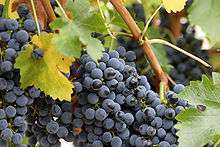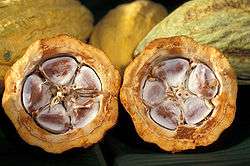Antioxidant effect of polyphenols and natural phenols

A polyphenol antioxidant is a type of antioxidant containing a polyphenolic substructure. Numbering over 4,000 distinct species, many of these compounds have antioxidant activity in vitro but are unlikely to have antioxidant roles in vivo.[1][2] Rather, they may affect cell-to-cell signaling, receptor sensitivity, inflammatory enzyme activity or gene regulation.[2][3]
Evolutionary perspective
From about 500 million years ago, freshwater and terrestrial plants slowly optimized the production of “new” endogenous antioxidants, such as ascorbic acid (vitamin C), natural phenols (including flavonoids) and polyphenols, tocopherols, etc. A few of these appeared more recently, in the last 50–200 million years, in fruits and flowers of angiosperm plants. In fact, the angiosperms (the flowering plants), the dominant type of plant today (and most of their antioxidant pigments) evolved during the late Jurassic period.
Sources of polyphenol antioxidants
The main source of polyphenols is dietary, since they are found in a wide array of phytochemical-bearing foods. For example, honey; most legumes; fruits such as apples, blackberries, blueberries, cantaloupe, pomegranate, cherries, cranberries, grapes, pears, plums, raspberries, aronia berries, and strawberries; and vegetables such as broccoli, cabbage, celery, onion and parsley are rich in polyphenols. Red wine, chocolate, black tea, white tea, green tea, olive oil[4] and many grains are sources. Ingestion of polyphenols occurs by consuming a wide array of plant foods.
Biochemical theory
The regulation theory considers a polyphenol antioxidant’s ability to scavenge free radicals and up-regulate certain metal chelation reactions. Various reactive oxygen species, such as singlet oxygen, peroxynitrite and hydrogen peroxide, must be continually removed from cells to maintain healthy metabolic function. Diminishing the concentrations of reactive oxygen species can have several benefits possibly associated with ion transport systems and so may affect redox signaling.
The “deactivation” of oxidant species by polyphenolic antioxidants (POH) is based, with regard to food systems that are deteriorated by peroxyl radicals (R•), on the donation of hydrogen, which interrupts chain reactions:
R• + PhOH → R-H + PhO•
Phenoxyl radicals (PO•) generated according to this reaction may be stabilized through resonance and/or intramolecular hydrogen bonding, as proposed for quercetin, or combine to yield dimerisation products, thus terminating the chain reaction:
PhO• + PhO•→ PhO-OPh [5]
Potential biological consequences

Consuming dietary polyphenols may be associated with effects in higher animal species:
- Possible reduction in inflammation such as in coronary artery disease[6] including specific research on endothelial cells via downregulation of oxidative LDL.[7]
- Other possible effects may result from consumption of foods rich in polyphenols, but are not yet proved scientifically in humans so are not allowed as health statements by regulatory authorities like the U.S. Food and Drug Administration (FDA).[8] Among these are possible anti-aging effects in skin.[9] Further research may discern if polyphenol antioxidants have biological roles in vivo.[10][11]
Difficulty in analyzing effects of specific chemicals

It is difficult to evaluate the physiological effects of specific natural phenolic antioxidants, since such a large number of individual compounds may occur even in a single food and their fate in vivo cannot be measured. For example, over sixty different chemically distinct flavonoids are known to occur in a given red wine. The polyphenol content of wines is usually evaluated by the Folin-Ciocalteu reagent which correlates well with alternative chemical and biological procedures for determining antioxidant potential.[12]
Other more detailed chemical research has elucidated the difficulty of isolating individual phenolic antioxidants. Because significant variation in phenolic content occurs among various brands of tea, there are possible[13] inconsistencies among epidemiological studies implying beneficial health effects of phenolic antioxidants of green tea blends. The Oxygen Radical Absorbance Capacity (ORAC) test is a laboratory indicator of antioxidant potential in foods and dietary supplements. However, ORAC results cannot be confirmed to be physiologically applicable.[2]
Practical aspects of dietary polyphenol antioxidants
There is debate regarding the total body absorption of dietary intake of polyphenolic compounds. While some indicate potential health effects of certain specific polyphenols, most studies demonstrate low bioavailability and rapid excretion of polyphenols, indicating their potential roles only in small concentrations in vivo.[1][2][3] More research is needed to understand the interactions between a variety of these chemicals acting in concert within the human body. In particular there is evidence that some combinations of foods may inhibit efficient intestinal transfer of certain polyphenol antioxidants; refined sugars, for example, have been shown to impede this uptake under certain circumstances.[14] Furthermore, caution should be exercised in attempting diets depending largely on dietary supplements as opposed to a broad array of food sources, since the quality and concentrations of beneficial chemicals in some commercial products is subject to question.
Topical application of polyphenol antioxidants
There is little evidence that reactive oxygen species play a role in the process of skin aging.[15] The skin is exposed to various exogenous sources of oxidative stress, including ultraviolet radiation whose spectral components may be responsible for the extrinsic type of skin aging, sometimes termed photoaging. It has been shown not only that increased levels of protective low molecular weight antioxidants through a diet rich in phytochemicals, but also by direct topical dermal application of low molecular weight antioxidants, notably vitamins C and E, as well as lipoic acid, may confer protective effects against oxidative stress.[15] However, controlled long-term studies on the efficacy of low molecular weight antioxidants in the prevention or treatment of skin aging in humans are absent.
Combination of antioxidants in vitro
Synergistic or antagonistic effects of phenolic mixtures
Experiments on linoleic acid subjected to 2,2′-azobis (2-amidinopropane) dihydrochloride-induced oxidation with different combinations of phenolics show that binary mixtures can lead to either a synergetic effect or to an antagonistic effect.[16]
Antioxidant levels of purified anthocyanin extracts were much higher than expected from anthocyanin content indicating synergistic effect of anthocyanin mixtures.[17]
While most antioxidants go directly from an active to an inactive role, emblicanins utilize a multilevel cascade of antioxidant compounds resulting in a prolongation of its antioxidant capabilities. Emblicanin A (one of the key compounds in emblicanins) aggressively reacts with free radicals. After it neutralizes a free radical, emblicanin A is transformed into emblicanin B, another antioxidant. Emblicanin B in turn also reacts with free radicals and is transformed into emblicanin oligomers. This makes emblicanins one of the best free radical scavenging antioxidant.[18]
Effect in combination with another non-phenolic antioxidant
Experiments with binary mixtures of natural phenolic antioxidants with a non-phenolic antioxidant -ascorbic acid- show that phenolics exhibit antagonism when combined with this latter compound. This is described as to the regenerating ability of the most efficient antioxidant at the expense of the less efficient one.[19]
Nevertheless, experiments led with hydroxytyrosol, a major constituent of olive oil and α-tocopherol show a synergistic effect.[20]
Antioxidant capacity tests
- ferricyanide reducing power
- 2,2-diphenyl-1-picrylhydrazyl radical scavenging activity[21]
See also
- List of phytochemicals in food
- List of antioxidants in food
- Health effects of polyphenols
- Free-radical theory
Other articles
- Asymmetric dimethylarginine
- Coronary artery disease
- Low density lipoprotein
- Nitric oxide
- Resveratrol
- Astaxanthin
References
- 1 2 Williams RJ, Spencer JP, Rice-Evans C (April 2004). "Flavonoids: antioxidants or signalling molecules?". Free Radical Biology & Medicine. 36 (7): 838–49. doi:10.1016/j.freeradbiomed.2004.01.001. PMID 15019969.
- 1 2 3 4 Frei B (April 1, 2009). "Controversy: What are the true biological functions of superfruit antioxidants?". Natural Products Information Center. Archived from the original on March 6, 2010.
- 1 2 Virgili F, Marino M (November 2008). "Regulation of cellular signals from nutritional molecules: a specific role for phytochemicals, beyond antioxidant activity". Free Radical Biology & Medicine. 45 (9): 1205–16. doi:10.1016/j.freeradbiomed.2008.08.001. PMID 18762244.
- ↑ Grossi, Marco; Di Lecce, Giuseppe; Arru, Marco; Gallina Toschi, Tullia; Riccò, Bruno (2015). "An opto-electronic system for in-situ determination of peroxide value and total phenol content in olive oil". Journal of Food Engineering. 146: 1–7. doi:10.1016/j.jfoodeng.2014.08.015.
- ↑ Flavonoids as antioxidants: determination of radical Scavenging efficiencies. Bors W, Heller W, Michel C and Saran M. Methods in Enzymology, 1990, 186, pages 343-355, doi:10.1016/0076-6879(90)86128-I
- ↑ Muldoon MF, Kritchevsky SB (February 1996). "Flavonoids and heart disease". BMJ. 312 (7029): 458–9. doi:10.1136/bmj.312.7029.458. PMC 2349967
 . PMID 8597666.
. PMID 8597666. - ↑ Serafini M, Laranjinha JA, Almeida LM, Maiani G (November 2000). "Inhibition of human LDL lipid peroxidation by phenol-rich beverages and their impact on plasma total antioxidant capacity in humans". J. Nutr. Biochem. 11 (11–12): 585–590. doi:10.1016/S0955-2863(00)00124-8. PMID 11137897.
- ↑ Paul Gross (March 1, 2009), New Roles for Polyphenols. A 3-Part report on Current Regulations & the State of Science, Nutraceuticals World
- ↑ Vieira O, Escargueil-Blanc I, Meilhac O, et al. (February 1998). "Effect of dietary phenolic compounds on apoptosis of human cultured endothelial cells induced by oxidized LDL". Br. J. Pharmacol. 123 (3): 565–73. doi:10.1038/sj.bjp.0701624. PMC 1565185
 . PMID 9504398.
. PMID 9504398. - ↑ Owen RW, Giacosa A, Hull WE, Haubner R, Spiegelhalder B, Bartsch H (June 2000). "The antioxidant/anticancer potential of phenolic compounds isolated from olive oil". Eur. J. Cancer. 36 (10): 1235–47. doi:10.1016/S0959-8049(00)00103-9. PMID 10882862.
- ↑ Fitó M, Covas MI, Lamuela-Raventós RM, et al. (June 2000). "Protective effect of olive oil and its phenolic compounds against low density lipoprotein oxidation". Lipids. 35 (6): 633–8. doi:10.1007/s11745-000-0567-1. PMID 10901425.
- ↑ Brenna OV, Pagliarini E (October 2001). "Multivariate analysis of antioxidant power and polyphenolic composition in red wines". J. Agric. Food Chem. 49 (10): 4841–4. doi:10.1021/jf0104376. PMID 11600032.
- ↑ C. Fajardo-Lirai, S. M. Henning, H. W. Lee, V. L. W. Go, and D. Heber,. Department Family Environmental Sciences/Nutrition, Dietetics & Food Science, California State University, Northridge and, UCLA Center for Human Nutrition, Session 46C, 2002 Annual meeting of Food Expo, Anaheim, Ca
- ↑ Lotito SB, Frei B (January 2004). "Relevance of apple polyphenols as antioxidants in human plasma: contrasting in vitro and in vivo effects". Free Radic. Biol. Med. 36 (2): 201–11. doi:10.1016/j.freeradbiomed.2003.10.005. PMID 14744632.
- 1 2 Podda M, Grundmann-Kollmann M (October 2001). "Low molecular weight antioxidants and their role in skin ageing". Clin. Exp. Dermatol. 26 (7): 578–82. doi:10.1046/j.1365-2230.2001.00902.x. PMID 11696061.
- ↑ Antioxidant activity of phenolic compounds in 2,2′-azobis (2-amidinopropane) dihydrochloride (AAPH)-induced oxidation: Synergistic and antagonistic effects. M. N. Peyrat-Maillard, M. E. Cuvelier and C. Berset, Journal Of The American Oil Chemists' Society, 2003, Volume 80, Number 10, pages 1007-1012, doi:10.1007/s11746-003-0812-z
- ↑ Color and Antioxidant Properties of Cyanidin-Based Anthocyanin Pigments. Florian C. Stintzing, Angela S. Stintzing, Reinhold Carle, Balz Frei and Ronald E. Wrolstad, J. Agric. Food Chem., 2002, 50 (21), pages 6172–6181, doi:10.1021/jf0204811
- ↑ International Conference on Newer Developments in Drug Discovery From Natural Products and Traditional Medicines-An Overview. K K Bhutan, 2008, page 16
- ↑ Binary mixtures of natural polyphenolic antioxidants with ascorbic acid: impact of interactions on the antiradical activity. Aoun M and Makris DP, International Food Research Journal, 2012, 19(2), pages 603-606 (article)
- ↑ Antioxidant activity of tocopherols and phenolic compounds of virgin olive oil. M. Baldioli, M. Servili, G. Perretti and G. F. Montedoro, Journal Of The American Oil Chemists' Society, 1996 Number 11, Volume 73, pages 1589-1593, doi:10.1007/BF02523530
- ↑ Characterization of monomeric and oligomeric flavan-3-ols from barley and malt by liquid chromatography–ultraviolet detection–electrospray ionization mass spectrometry. Marketa Dvorakova, Manuela M. Moreira, Pavel Dostalek, Zuzana Skulilova, Luís F. Guido and Aquiles A. Barros, Journal of Chromatography A, 2 May 2008, Volume 1189, Issues 1–2, Pages 398–405, doi:10.1016/j.chroma.2007.10.080
